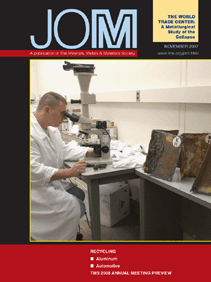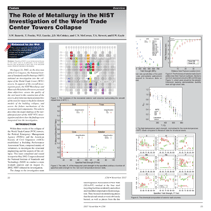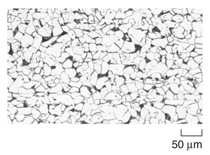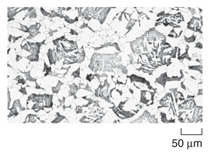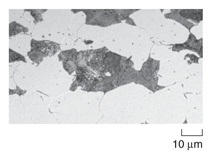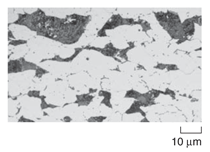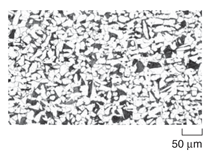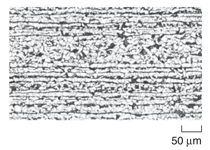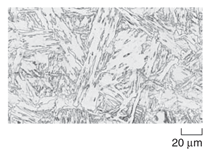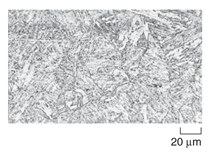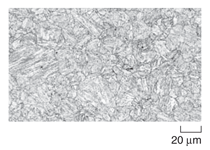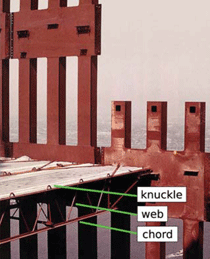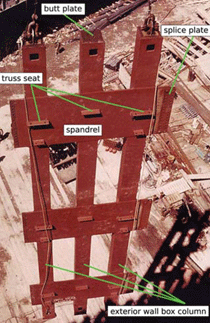Disclaimer: The
policy of NIST is to use the International System of Units (metric
units) in all publications. In this document, however, units are
presented in metric units or the inch-pound system, whichever is
prevalent in the discipline.
Editor’s Note: For a much-cited, early metallurgical analysis of the World Trade Center towers collapse, see “Why Did the World Trade Center Collapse? Science, Engineering, and Speculation” in the December 2001 issue.
On August 21, 2002, on the direction
of the U.S. Congress, the National Institute
of Standards and Technology (NIST)
initiated an investigation into the collapse
of the World Trade Center (WTC)
towers. In support of the overall investigation
goals, the NIST Metallurgy and
Materials Reliability Divisions pursued
three objectives: assess the quality of
the steel used in the construction of the
towers, determine mechanical properties
of the steel for input to the finite element
models of the building collapse, and
assess the failure mechanisms of the
recovered steel components. This article
describes the major findings of the metallurgical
part of the NIST WTC investigation
and shows how the findings were
integrated into the investigation.
INTRODUCTION
The National Institute of Standards and Technology (NIST) Building and Fire Research
Laboratory and its contractors created a complex model to understand the collapse of
the towers. Three semi-independent parts comprised the model: a model of the aircraft
impact and initial damage, a model of the dynamic spread of resulting fires and the
thermal environment they produced, and a structural model of the resulting deformation
and eventual collapse of the towers. The output of the impact and fire models fed into the
structural collapse model.
The aircraft impact model enabled investigators to determine the damage to the interior
of the building, which was not visible to witnesses outside, and to determine the dispersion
of jet fuel. This model included about nine floors of each building and a highly detailed
model of the aircraft and its fuel. It used about two million elements, employed time steps
of about 1 microsecond, and modeled a fraction of the first second of the disaster. The
output of the model was the structural state of the building after the impact, but before
the fires began. It included estimates of the path and distribution of the debris and fuel,
the areas where the spray-applied fire-resistive material was stripped from the columns
and floor trusses, and estimates of the number and location of severed or damaged core
columns. The aircraft impact model used material models of the deformation behavior of
the structural steels, both at quasi-static and at high strain rate.
The fire model employed the NIST Fire Dynamics Simulator (FDS), a computational
fluid dynamics model that numerically solves a form of the Navier–Stokes equations to
model thermally driven flow. The National Institute of Standards and Technology has
used FDS for forensic reconstruction of fires before the WTC investigation. The building
model of the fires, which used actual tenant floor layout information, contained eight
relevant floors around the impact site. Each floor was divided into a computational grid
of cells approximately 0.5 m on a side. The output of the fire model was the complete
thermal history of each floor, which was then used to predict the temperatures of the
beams and columns.
The structural models of the two towers were used to understand the collapse
hypotheses. The global model examined a base case as well as a severe damage and fire
case for each tower, and took as input the state of the damaged buildings predicted by
the impact model and the thermal history of the floors predicted by the fire model. The
global structural model, which necessarily employed simplifying assumptions because
of its computational size, was based on more detailed component models that analyzed
the response of individual components, such as the floor trusses, their connections at the
seats, and the shear knuckles that provided shear transfer between the concrete floor and
the truss assemblies. The behavior of the exterior wall column panels was also modeled
in greater detail. The results of the more detailed component models indicated which
failure and deformation modes could be neglected in the global model. The structural
models employed steel material models of the room and elevated-temperature stress-strain
behavior, and the elevated-temperature creep behavior. |
|
THE CONSTRUCTION OF THE TOWERS
|
Seven steel companies supplied structural steel to the World Trade Center (WTC)
construction. Above the seventh floor, the structure of the towers comprised four main
subsystems; a different steel fabricator supplied each. Pacific Car and Foundry of Seattle,
Washington, fabricated the closely spaced exterior wall column panels that gave the
buildings their instantly recognizable shape. Stanray Pacific of Los Angeles, California,
fabricated the enormous box and wide-flange columns that made up the core. Laclede
Steel of St. Louis, Missouri, fabricated the thousands of floor trusses that spanned the
opening between the core and the perimeter tube. Finally, Montague-Betts of Lynchburg,
Virginia, fabricated all the beams above the ninth floor.
Exterior Wall Columns
The closely spaced exterior columns formed a stiff tube that resisted all the wind loads
and a portion of the gravity load. The individual columns were roughly 14 in. square, and
were fabricated by welding individual plates into box columns. Three adjacent columns,
each three stories high, were joined by deep, horizontal spandrel plates at every floor to
form a panel. Figure A shows a three-story tall, three-column wide exterior wall panel
being lifted into place, and identifies the major structural components in the exterior
wall.
Once in place, the panels were bolted on the end butt plates and at splice plates that
connected adjacent spandrels. Nearly every panel assembly was unique, and each was
intended for a specific location on a given face of one building. In the lower floors, the
individual plates that made up the perimeter columns were up to 1 in. thick, but those in
the fire and impact floors of interest were typically 0.25 in. thick. Yawata Iron and Steel
(now Nippon Steel) supplied most of the steel for the perimeter columns.
The design of the towers was also unusual in that the original plans called for 14
different strength grades of steel, as low as 36 ksi and as high as 100 ksi. Ordinary
building construction might only use two or three strength grades. Each column in a
three-column, exterior wall column panel could be fabricated from a different grade of
steel as could the three spandrels. Because the wind loads differed between the different
compass directions, the distribution of column strengths and thicknesses on each face
of each building was unique; the two towers were not identical copies. In the floors of
interest for the collapse model for WTC 1, the perimeter column plates were typically FY
= 60 ksi.
Core Columns
The core of the building, which carried primarily gravity loads, was
made up of a
mixture of massive box columns made from three-story long plates, and
heavy rolled
wide-flange shapes. In general, the box columns carried the load in the
lower stories,
while the rolled shapes were used in the upper floors, but each type
existed in the fire
and impact zones. Most of the steel was specified as FY = 36 ksi. The
plates for the box columns came from Japanese mills and were fabricated
on the west coast and shipped
to New York. Japanese and British steel mills supplied most of the
wide-flange columns
and beams used above the seventh floor, which were detailed by a
fabricator on the east
coast.
Floor Trusses
Lightweight floor trusses supported the concrete floors that spanned the open space
between the conventionally framed core and the exterior wall columns. The chords of
the floor trusses were fabricated from 0.25 in. or 0.375 in. L-angles, while their webs
were typically made from a single length of 0.75 in. round bar. Laclede Steel rolled the
shapes from steel made in its own electric-arc furnace. It also welded the individual
truss sections, and then shipped them by rail to New Jersey, where the erection company
assembled them into floor panels that were lifted by crane into place. Figure A also
shows a completed floor panel before the concrete floor was poured. The trusses were
bolted and welded to seats on the spandrels
of the exterior wall column panels. The
truss seats on the opposite end at the core,
not visible in Figure A, were similar. The
webs projected above the level of the truss
top chord and formed a knuckle to provide
a composite action that tied the concrete
floor to the floor trusses. |
|
THE FAILURE OF THE TOWERS
|
At 8:46:30 the first airplane struck the north wall of World Trade Center (WTC) 1
between floors 93 and 98. About 15% of the jet fuel burned in the fireball outside the
building. Another 15% burned inside the building immediately. The rest fueled the fires
that started. The overpressure from the fireball blew out many of the windows, which
subsequently provided oxygen for fires. The impact damaged or severed 38 of 59 exterior
columns on the north wall, and, based on the aircraft impact analysis, 9 of the 47 core
columns. The passage of the impact debris through the tower stripped the insulation from
columns and floor trusses on the impact floors. Over the next 102 min., the fires moved
from the north (impact) side to the south side. Eighty minutes after impact, the south wall
began to bow inward. At 97 min., it reached its maximum observed displacement of 1.4
m. Just before collapse, the building section above the impact zone tilted to the south, and
at 10:28:25, 102 min. after impact, WTC 1 began to collapse.
The second airplane struck the south wall of WTC 2 at 9:02:59 between floors 78
and 84. The effects of the fireball were similar to those in WTC 1. The impact damaged
32 of 59 exterior wall columns, and based on the aircraft impact analysis, 11 of 47
core columns. As in WTC 1, the passage of the impact debris stripped insulation from
columns and fl oor trusses. Unlike WTC 1, the fire moved quickly to the east side of the
building, but then remained there. Within ten minutes of impact, the east wall began to
bow inward. Just before collapse, the building section above the impact zone tilted to the
east and south, and at 9:58:59, 56 minutes after impact, WTC 2 began to collapse.
The Most Probable Collapse Sequence
The investigation team integrated the photographic record, the eyewitness accounts,
the experimental results, and the results of the aircraft impact analysis, fire spread and
growth analysis, heat conduction analysis, and structural response analysis to determine
the probable collapse sequence for each tower. Report NIST NCSTAR 1-6, from which
this summary is abstracted, summarizes the observations, results, and findings in much
greater detail.
The sequences of events leading to collapse initiation were similar, but not identical,
for each tower. Four major structural events were common to both sequences. First, the
floors that lost insulation due to debris impact sagged as the truss members deformed
and buckled under elevated steel temperature. The sagging floors pulled inward at the
column connections and caused the exterior wall to bow inward. Next, the exterior wall
bowed and plastically buckled under the combined effects of the reduced strength at
elevated temperatures, increased axial loads redistributed from the severed columns,
pull-in forces from sagging floors, and loss of lateral support due to failure of truss seat
connections. Then, the core columns weakened under the combined effects of structural
impact damage, reduced elevated temperature strength, and plastic buckling of core
columns. In addition, the loads on the remaining core columns increased as gravity loads
redistributed from the damaged core columns. Finally, the gravity loads redistributed
because of the impact damage, restrained thermal expansion, weakening of the core,
leaning of the section above the impact damage, and bowing and buckling of exterior
walls. The hat truss primarily redistributed the gravity loads from the core to the exterior
walls, but the adjacent exterior walls redistributed load primarily through the spandrels.
All three major subsystems—the building core, the building floors, and the exterior
walls—played a role in the structural collapse sequence for WTC 1 and WTC 2.
Role of the Building Core
The core columns were designed to carry the building gravity loads and were loaded to
approximately 50% of their capacity before the aircraft impact.
The core columns were weakened significantly by thermal effects and by the aircraft
impact damage. Thermal effects dominated the weakening of WTC 1. As the fires
moved from the north to the south side of the core, the WTC 1 core was weakened over
time by significant creep strains on its south side. Aircraft impact damage dominated
the weakening of WTC 2. Immediately after impact, the vertical displacement at the
southeast corner of the WTC 2 core increased 15 cm, from 10 cm to 25 cm. With the
impact damage, the core subsystem leaned to the southeast and was supported by the
south and east floors and exterior walls.
Gravity loads redistributed from the core to the exterior faces primarily through the
hat truss due to aircraft impact and thermal effects. The WTC 1 core carried 1% less load
after impact but 20% less after thermal weakening. The WTC 2 core carried 6% less load
after impact and 2% less load after thermal weakening.
Additional axial loads that were redistributed to the exterior columns from the core
were not significant (only about 20% to 25% on average), because the exterior columns
were loaded to only approximately 20% of their capacity before the aircraft impact.
Role of the Building Floors
The floors were designed to support occupancy loads and transfer them to the core
and exterior columns. They were also designed to act as horizontal diaphragms when the
buildings were subject to high winds.
In the collapse of the towers, the floors provided inward pull forces as they sagged
signifi cantly under thermal loads. However, the sagging floors continued to support their
floor loads despite the dislodged insulation and extensive fires. Some truss seat connections
with dislodged insulation at the exterior columns did fail and disconnect from the exterior
wall under thermal loads. Floor disconnections increased the unsupported length of the
exterior columns and distributed floor loads to adjacent truss seats. No inward pull forces
existed where the floors were disconnected.
Role of Exterior Walls
Column instability over an extended region of the exterior face ultimately triggered
the global system collapse, because the loads could not be redistributed through the hat
truss to the already weakened building core. In the area of exterior column buckling,
loads transferred through the spandrels to adjacent columns and adjacent exterior walls.
As the exterior wall buckled, on the south face of WTC 1 and the east face of WTC 2,
column instability propagated to adjacent faces and caused the initiation of the building
collapse.
The exterior wall instability was induced by a combination of thermal weakening of the
columns, inward pull forces from sagging floors, and to a much lesser degree, additional
axial loads redistributed from the core.
Conclusions of the Analysis
Floor sagging and inward bowing of an exterior wall were necessary but not sufficient
conditions to initiate collapse. In both WTC 1 and WTC 2, significant weakening of the
core due to aircraft impact damage and thermal effects was also necessary. The National
Institute of Standards and Technology considered the observed performance, evidence,
and analysis results for each tower, and reached two conclusions. First, in the absence
of structural and insulation damage, a conventional fire substantially similar to or less
intense than the fires encountered on September 11, 2001 likely would not have led to
the collapse of a WTC tower. Second, the towers likely would not have collapsed under
the combined effects of aircraft impact and the subsequent multi-floor fires encountered
on September 11, 2001 if the insulation had not been widely dislodged or had been only
minimally dislodged by aircraft impact.
The existing thermal insulation, had it not been stripped off in the impact, would have
been sufficient to keep the steel temperatures low enough to minimize deformation. Also,
the investigation team neither found nor invoked any extraordinary events, beyond the
terrorist attack that damaged the structure and removed the insulation, that led to the
collapse of the towers.
The difference in the time it took for each WTC tower to collapse was due primarily to
the differences in structural damage, the time it took the fires to travel from the impact area
across the floors and core to critical locations, and the time it took to weaken the core and
exterior columns. The structural damage to the WTC 2 core was asymmetric, including a
corner core column that was severed. The damage to WTC 1 was more symmetrical; it was
located in the center portion of the core and extended from the north side to the south side.
The fires in WTC 2 reached the east side of the building more quickly (within 10 to 20
minutes) than the 50 to 60 minutes it took for the fires in WTC 1 to reach the south side. |
Within three weeks of the collapse of
the World Trade Center (WTC) towers,
the Federal Emergency Management
Agency (FEMA) and the American
Society of Civil Engineers (ASCE)
established a Building Performance
Assessment Team, composed mainly of
volunteers, to investigate the structural
engineering and fire aspects of the collapse.
This team completed and issued
its report in May 2002. Congress directed
the National Institute of Standards and
Technology (NIST) to conduct a more
in-depth analysis and on August 21,
2002, NIST initiated its investigation.
The charge to the investigation team comprised four major parts.
- “Determine why and how WTC 1
and WTC 2 collapsed following
the initial impacts of the aircraft
and why and how WTC 7 collapsed.
- Determine why the injuries and
fatalities were high or low depending
on location including all technical
aspects of fire protection,
occupant behavior, evacuation,
and emergency response.
- Determine what procedures and
practices were used in the design,
construction, operation, and maintenance
of WTC 1, 2, and 7.
- Identify, as specifically as possible,
areas in current building and
fire codes, standards, and practices
that warrant revision.”
The metallurgical analysis of the steel,
described here, supported the modeling
effort of the investigation. In support of
the overall investigation goals, the NIST
Metallurgy and Materials Reliability
Divisions pursued three objectives:
assess the quality of the steel, determine
mechanical properties of the steel for
input to the finite element models of the
building collapse, and assess the failure
mechanisms of the recovered steel components.
The body of this manuscript describes
the major findings of the metallurgical
part of the NIST WTC investigation and
shows how the findings were integrated
into the investigation. Sidebars describe
the construction of the towers, the modeling
of building performance, and the
probable collapse sequences, which were
primary outputs of the investigation.
THE METALLURGICAL INVESTIGATION
The Recovery Effort and the
Structural Steel Elements
During the recovery effort after September
11, and before NIST began its
collapse investigation, volunteers from
FEMA, ASCE, NIST, the National Science
Foundation (NSF), and the Structural
Engineers Association of New York
(SEAoNY) worked at the four steel
recycling facilities to identify and collect
steel members important to the investigation.
They focused on identifying pieces
that the aircraft struck or were obviously
burned, as well as pieces from the fire and impact zone. The National Institute
of Standards and Technology arranged
to have these pieces shipped to its facility
in Gaithersburg, Maryland. The
National Institute of Standards and
Technology investigation team members
cataloged the items and attempted to
identify their original locations in the
towers, using their dimensions and markings.
In all, NIST cataloged 236 structural
steel elements:
- Ninety exterior column panels, of
which 42 were unambiguously
identified. Of those identified, 26
came from the fire and impact
floors, and four of these had been
struck by the airplane that hit
WTC 1.
- Fifty-five core columns, of which
12 were unambiguously identified. Four of the identified columns
came from the fire and impact
zones.
- Twenty-three pieces of floor truss.
Unfortunately, these elements had
no identifying marks, so their
original location in the towers is
unknown.
- Twenty-five pieces of the channel
that supported the floor trusses at
the core; all are of unknown location.
- Forty-three miscellaneous pieces
including bolts, pieces of aluminum
facade, and elements from
WTC 5.
Although many of the individual recovered elements are rather large, the
collection represents less than 0.5 % of
the more than 200,000 tons of steel used
in the buildings. It does include, however,
representative samples of all the relevant
steels necessary for estimating properties
for the impact and collapse models.
Given the difficulties in locating, identifying,
and safeguarding elements in the
field, the extent of the collection is
impressive. As an example of the coverage,
Figure 1 shows the location of the
recovered exterior columns surroundingthe impact hole in WTC 1.
Room-Temperature Strengths
and Standards
The sidebar “The Construction of the
Towers” describes the construction
of the three relevant building
subsystems: the exterior columns, the
massive core columns, and the trusses
that spanned the opening between the
exterior wall and the core and supported
the floors.
Because of their high strength, the
steels used in the exterior wall columns
are not ordinary construction steels. A
typical high-rise building might use steel
of only three strength grades, based on
minimum yield strength (FY). In contrast,
the WTC structural plans specified
steels that began at a minimum yield
strength FY = 36 ksi and increased from
FY = 40 ksi to FY = 85 ksi in 5 ksi
(34.5 MPa) increments. Corner elements
in the exterior wall often used FY =
100 ksi steels. Contemporaneous construction
documents indicate that the
lowest strength exterior wall column
steels were supplied to the ASTM A 36
standard, but all the steels with strengths
above that value conformed to proprietary
grades that the Port Authority of
New York and New Jersey, the building
owner, authorized. Yawata Iron and Steel,
now Nippon Steel, supplied most of the
steel plate for the exterior wall columns.
The plate that faced the interior of the
building usually came from a domestic
mill, however.
Japanese and British mills supplied
most of the steel for the core columns.
These plates and hot-rolled, wide-flange
shapes were mostly FY = 36 ksi ASTM
A 36. Little information survived about
which steel mills supplied the core
beams.
The floor truss angles and webs were specified to a mixture of ASTM A 36
and ASTM A 242. The latter is a high-strength,
low-alloy (HSLA) steel, though
the composition limits in the WTC construction
era differ from those of the
standard today. Even when the plans
called for A 36, the mill often supplied
an HSLA steel with substantially higher
yield strength.
The investigation team characterized
the room-temperature tensile behavior
for examples of all relevant strength
levels. Figure 2 shows the ratio, R, of
the measured yield strength of the material
to specified yield strength as indicated
by the design drawings as a function
of specified yield strength for the
123 room-temperature longitudinal tension
tests conducted as part of the investigation.
The tests are subdivided by the
type of structural element: exterior wall
columns, core columns, truss seats, and
truss components. Each structural element
is further subdivided into relevant
components, such as truss angles and
webs, exterior wall columns and spandrels,
and core column plates and wideflange (WF) shapes. Multiple specimens
from each plate or shape were tested.
In general, the measured yield
strengths are about 15% higher than
specified. This extra strength is consistent
with the results of WTC-era studies on
the expected strengths of structural steel. The measured strength almost always
exceeds the specified strength, so that
variations in processing do not produce
heats that must be scrapped. Several of
the tests, however, produced R < 1. The
appearance of these tests that produced
yield strengths less than the specified
minimum cannot be interpreted as meaning
that the steel was defective, however.
The mill-test-report strength for a heat
of steel is a quality control check. It is
not a guarantee that all regions in the
heat will have the minimum strength.
Extensive statistical studies (Alpsten,
AISI) have demonstrated that variability
within the heat is small enough that the
usual factor of safety in design is adequate.
Furthermore, in the case of the
tests of the core column steels, specimens
were harvested out of necessity from
deformed areas of the recovered columns.
The existing deformation, calculated
from the radius of curvature, was
more than sufficient to remove any yield
point behavior under which these A 36
steels would have been qualified. The
existence of a yield point, which most
of the tests of the steels with R < 1 lacked,
could add up to 10% to the measured
and reported strengths. The original,
undeformed steels would likely have had
yield strengths above the specified FY
= 36 ksi.
In summary, the strengths of the
recovered steels measured at NIST are
consistent with the specifications under
which they were delivered. The tests
produced no evidence that the steels were
in any way defective, and their NIST-measured
chemical compositions were
in almost all cases consistent with the
chemical requirements of the standards
under which they were delivered.
High-Strain-Rate Properties
Understanding and correctly modeling
the high-strain-rate properties of the steel
in the exterior wall and core columns
was critical to estimating the amount of
structural damage that the aircraft impact
caused, which was one of the goals of
the impact model. To this end, the investigation
focused on the exterior wall and
core columns using conventional high-rate
tensile tests to estimate the strain-rate
sensitivity of the strength and to examine
the effect of strain rate on the ductility.
The tests employed strain rates up to
500 s–1, which were similar to the maximum rates predicted by the aircraft
impact models. The investigation team
used the experimentally measured stress-strain
curves to provide a generic model
of the strength as a function of strain rate
to the team modeling the aircraft
impact.
The measured strain rate sensitivities
were similar to those of other structural
steels reported in the last 25 years. Figure
3 shows the strain-rate sensitivity of the
yield strength for selected exterior wall
and core columns, overlaid on reported
data for similar structural steels. Significantly, none of the 13 exterior wall
and core column steels tested exhibited
any brittle behavior, even at the highest
strain rates tested. In general, the ductility
increased slightly with increasing
strain rate.
Macroscopically, all the exterior wall
column failures due to aircraft impact
that NIST examined were also ductile.
In WTC 1, the aircraft severed several
of the columns, often at the level of the
concrete floor. Figure 4 shows that the
web plates from panels struck by the
aircraft (see Figure 1 for panel locations)
necked over a distance of about 12 mm,
reducing the plate to less than half of its
original thickness due to the deformation,
which indicates ductile failure. Had the
failures been brittle, the exterior wall
columns would have absorbed less of
the impact energy; consequently more energy would have been available to
damage the core columns.
In three of the four columns recovered
from WTC 1 that the airplane hit, the
columns split along the joints between
the individual plates, specifically in the
heat-affected zone (HAZ) in the web
plate, but there was no evidence that the
failure was due to lamellar tearing.
High-Temperature Mechanical
Properties
Structural steel becomes progressively
weaker with increasing temperatures
above about 300°C. For temperatures up
to about 500°C and the short times relevant
to fires in structures, the stress-strain
behavior can be treated as independent
of time. At higher temperatures,
time-dependent deformation, or creep,
contributes to the deformation, even over
these short times. Because creep deformation
is generally thought of as a longtime
phenomenon, it has often been
neglected in fire calculations. The WTC
collapse models included creep deformation
of the core columns, however.
Figure 5 compares the measured
0.02% offset yield strength of the relevant
recovered WTC steels to literature data
on similar construction steels from both
before and after the WTC construction
era. The yield strengths are normalized
by their room-temperature values to
collapse the behavior onto a single master curve. The response of the normalized
yield strength of the WTC steels is
similar to the behavior of the other
structural steels. It supports the commonly
held rule of thumb that the yield
strength at 538°C is about one-half that
at room temperature.
Figure 5 reports only the yield
strength, but the investigation team
provided a methodology for modeling
the shape of the true stress-strain curve
as a function of temperature and roomtemperature
tensile strength for all the
relevant steels.
In a parallel effort, the team characterized
the creep behavior of the steels used
for the floor trusses. The impact probably
dislodged their fireproofing.
Because their cross section was the
smallest, they were the most likely to
heat quickly. Based on the measured
creep response of floor truss steels, the
team developed a methodology for estimating
the creep properties of the
uncharacterized steels by scaling against
the room-temperature tensile strength.
Chemistry and Microstructure
Figure 6 displays the chemistry of
steels from the exterior wall columns as
a function of specified yield strength.
For each element, the plot is further
divided by origin of the steel plate within
the column. In general, the plots support
the historical evidence that the inner web
plate that faced the interior of the building
(denoted by green, filled circles)
came from a different mill than the plates
used in the flanges. Evidence is particularly
clear for the Si, V, Nb, and Cu
contents.
The plates in the exterior wall columns
and the core box columns were fabricated
by a “controlled rolling” process. By
stringent control of the hot work processing
in the austenitic state and the subsequent
cooling, this process produces fine
grain size and high-strength as-rolled
steels that require no post processing.
Using this practice, both hot-rolled
(typically FY < 70 ksi) and quenched-and-
tempered (FY = 70 ksi) low-alloy
grades were manufactured. The latter
was used where a higher strength-toweight
ratio was beneficial, such as for
the exterior wall columns located near
the corners and upper floors of the buildings.
Yawata Iron and Steel also manipulated
the alloy composition to yield the
specified plate properties (Figure 6),
leaving the carbon content constant for
nearly all steels (around 0.2% mass fraction),
which is low enough for good
weldability.
The hot-rolled steels had ferrite-pearlite
microstructures with a variety of
constituent morphologies. Polygonal and
irregular ferrite (Figure 7a) occurred in
all grades; the grain size decreased with
increasing yield strength. This grain
refinement was achieved primarily
through microalloying with vanadium
and niobium additions (see Figure 6).
An intragranular acicular or Widmanstätten
morphology occurred in some higher
strength steels with 60 ksi = FY < 70 ksi
as well as in steels that contained significant vanadium additions (e.g., steels
used for the floor truss components), as
shown in Figure 7b. This morphology
formed due to the continuous cooling
practices that dictated the degree of
undercooling during fabrication of the
plates. Similarly, the morphology of the
pearlite constituent of the hot-rolled
steels varied. Pearlite colonies in lowerstrength
steels were large, with a dense
but distinguishable lamellar structure
(Figure 8a). Pearlite colonies in higher-strength
steels were smaller and appeared
mottled. The lamellar spacing could not
be resolved using optical microscopy,
and the cementite phase (Fe3C) appeared
granular at times (Figure 8b). The difference
in pearlite appearance is associated
with the alloy chemistry and
deoxidation practices in use at the
time.
Steels with low manganese content
that were also aluminum-killed prefer entially form this mottled pearlite morphology.
The elevated aluminum levels
suggest an effort to significantly deoxidize
the steel.
The spatial distribution of these microstructural
constituents was frequently
not uniform. In general, the ferrite and
pearlite were uniformly distributed in
the lower strength plates (FY < 55 ksi),
floor truss components (chords and
webs), and floor truss seats (Figure 9a).
In contrast, ferrite and pearlite in the
higher-strength plates were distributed
into bands that were elongated in the
rolling plane, which resulted in a laminated
structure in cross section (Figure
9b). For some plates, regions near
the centerline were more heavily banded
than those near the surface. Constituent
banding in low-carbon steels is common
in hot-rolled plates and is caused by
chemical segregation through the thickness
of the plate. The surplus or deficiency of alloying elements in the bands
determines the transformation products
that form on cooling from the processing
temperature.
Quench-and-tempered plates exhibited
two morphologies. Ferrite grains in
steels with FY = 70 ksi were shaped like
broad needles or leaves and were surrounded
by coarse cementite precipitates
(Figure 10a). The morphology of the
ferrite constituent and distribution of the
cementite phase indicates either a coarse
Widmanstätten or bainitic structure.
Tempered martensite occurred in steels
with FY = 75 ksi (Figure 10b and 10c).
As the strength of the plate increased,
the remnants of ferrite lath boundaries
became more distinct, but the carbides
at the prior austenite grain and ferrite
lath boundaries became less discernible.
To strengthen and improve the hardenability
of the plates, chromium and
molybdenum were added.
CONCLUSION
Based on the metallurgical investigation
of the steel recovered from the WTC
collapse site, it was determined that the
mechanical properties and chemistry of
the steels used in the World Trade Center
towers were consistent with the specifications called for in the building plans.
Microstructurally, the lower-strength
exterior wall and core-column steels
were ferrite-pearlite control-rolled steels.
Higher-strength steels in the exterior wall columns were quenched and tempered.
Measured mechanical properties
at high strain rates, necessary for modeling
the impact of the aircraft, were
similar to other ordinary construction
steels. Neither high-rate tests nor recovered components gave any evidence of
brittle failure. The high-temperature
mechanical properties, necessary for
modeling the response to the fires, were
consistent with other construction
steels.
ACKNOWLEDGEMENTS
The National Institute of Standards
and Technology (NIST) thanks the volunteers
of the Structural Engineers
Association of New York for their efforts
in the recovery of the steel components:
Amit Bandyopadhyay, Anamaria Bonilla,
Peter Chipchase, Anthony Chuliver,
Edward DePaola, Louis Errichiello,
James Fahey, Ramon Gilsanz, Jeffrey
Hartman, David Hoy, Dean Koutsoubis,
Andrew McConnell, Rajani Nair, Alan
Rosa, David Sharp, Gary Steficek, and
Kevin Terry. They unselfishly spent countless
hours in the recovery yards searching
for these invaluable pieces that are
an integral component of the NIST World
Trade Center investigation. Further, for
their outstanding leadership roles
throughout the recovery effort we recognize
Ramon Gilsanz, primary leader
of the recovery effort; David Sharp,
coordinator of volunteer activities and
author of the guide used for the selection
of suitable pieces; and Audrey Massa of
Federal Emergency Management Agency
(FEMA), leader for documentation and
cataloguing of efforts and pieces to be
saved.
For their help in the recovery effort,
we acknowledge the FEMA/American
Society of Civil Engineers Building
Performance Assessment Team, Professor
A. Astaneh-Asl of the University of
California, Berkeley, California, and the
National Science Foundation.
For the initial storing of the structural
steel during the clean-up effort of the
World Trade Center site and for their
assistance and patience during the
review, abatement, and final removal of
pieces of interest to the investigation we
thank Blanford Land Development Corporation,
Hugo Neu Schnitzer, Inc., and
Metal Management, Inc.
The National Institute of Standards
and Technology also thanks the Port
Authority of New York and New Jersey
for its assistance in surveying, sectioning,
and transporting the technically significant structural steel collected by the
Port Authority and stored at John F.
Kennedy International Airport.
The authors thank Therese McAllister
and John Gross of the NIST Building
and Fire Research Laboratory for assistance
in writing the summary of the tower
collapse.
BIBLIOGRAPHY
The complete NIST World Trade Center reports
are available on-line at http://wtc.nist.gov. The
overview report is a good summary of the entire
investigation:
Final Report on the Collapse of the World Trade
Center Towers. NIST NCSTAR 1 (Gaithersburg,
MD: National Institute of Standards and Technology,
September 2005).
The metallurgical summary draws heavily on the
five reports of the mechanical and metallurgical
investigation:
Gayle, F.W., et al., “Federal Building and Fire Safety
Investigation of the World Trade Center Disaster:
Mechanical and Metallurgical Analysis of Structural
Steel,” NIST NCSTAR 1-3 (Gaithersburg, MD:
National Institute of Standards and Technology,
September 2005).
Luecke, W.E., et al., “Federal Building and Fire
Safety Investigation of the World Trade Center
Disaster: Contemporaneous Structural Steel
Specifi cations,” NIST NCSTAR 1-3A (Gaithersburg,
MD: National Institute of Standards and Technology,
September 2005).
Banovic, S.W., et al., “Federal Building and Fire Safety
Investigation of the World Trade Center Disaster:
Steel Inventory and Identifi cation,” NIST NCSTAR
1-3B (Gaithersburg, MD: National Institute of
Standards and Technology, September 2005).
Banovic S.W., et al., “Federal Building and Fire Safety
Investigation of the World Trade Center Disaster:
Damage and Failure Modes of Structural Steel
Components,” NIST NCSTAR 1-3C (Gaithersburg,
MD: National Institute of Standards and Technology,
September 2005).
Luecke W.E., et al., “Federal Building and Fire Safety
Investigation of the World Trade Center Disaster:
Mechanical Properties of Structural Steels,” NIST
NCSTAR 1-3D (Gaithersburg, MD: National Institute
of Standards and Technology, September 2005).
Banovic, S.W., et al., “Federal Building and Fire Safety
Investigation of the World Trade Center Disaster:
Physical Properties of Structural Steels,” NIST
NCSTAR 1-3E (Gaithersburg, MD: National Institute
of Standards and Technology, September 2005).
The collapse model is summarized in report NCSTAR
1-6:
Gross, J.L., et al., “Federal Building and Fire Safety
Investigation of the World Trade Center Disaster:
Structural Fire Response and Probable Collapse
Sequence of the World Trade Center Towers,” NIST
NCSTAR 1-6 (Gaithersburg, MD: National Institute
of Standards and Technology, September 2005).
Further details can be found in the following references:
Banovic S.W., T. Foecke, and F.W. Gayle, “Assessment
of Structural Steel from the World Trade Center
Towers, Part I: Recovery and Identifi cation of
Critical Structural Elements,” J. Fail. Anal. Prevent.,
6 (5) (2006), pp. 47–68.
Foecke, T., S.W. Banovic, and F.W. Gayle, “Assessment
of Structural Steel from the World Trade Center
Towers, Part II: Analysis of Images for Forensic
Information,” J. Fail. Anal. Prevent., 6 (5) (2006), pp.
70–85.
Banovic, S.W., T. Foecke, and F.W. Gayle, “Assessment
of Structural Steel from the World Trade Center
Towers, Part III: Physical Damage Caused by
Impact of Aircraft,” J. Fail. Anal. Prevent., 6 (5)
(2006), pp. 86–102.
Banovic S.W., and T. Foecke, “Assessment of Structural
Steel from the World Trade Center Towers, Part
IV: Experimental Techniques to Assess Possible
Exposure to High-Temperature Excursions,” J. Fail.
Anal. Prevent., 6 (5) (2006), pp. 103–120.
Foecke, T., S.W. Banovic, and F.W. Gayle, “Assessment
of Structural Steel from the World Trade Center
Towers, Part V: Forensic Photographic Evidence of
Tower Collapse Initiation and Progression,” J. Fail.
Anal. Prevent., 6 (5) (2006), pp. 121–128.
Specific references in this manuscript for standards
and strength:
AISI, “The Variation of Product Analysis and Tensile
Properties Carbon Steel Plates and Wide Flange
Shapes,” Contributions to the Metallurgy of Steel
(Washington, D.C.: American Iron and Steel
Institute, 1974).
Alpsten, G. A., “Variations in Mechanical and Cross-
Sectional Properties of Steel,” Planning and Design
of Tall Buildings, Volume 1b (New York: American
Society of Civil Engineers, 1972), pp. 755–805.
Specific references in this manuscript for literature
values for high-strain-rate mechanical properties:
Chatfield, D., and R. Rote, “Strain Rate Effects on
Properties of High Strength, Low Alloy Steels,”
(Warrendale, PA: Society of Automotive Engineers
(1974), publication no. 740177.
Couque, H., R.J. Asaro, J. Duffy, and S.H. Lee,
“Correlations of Microstructure with Dynamic and
Quasi-Static Fracture in a Plain Carbon Steel,” Met.
Trans. A, 19A (1988), pp. 2179–2206.
Davies, R., and C. Magee, “The Effect of Strain-Rate
Upon the Tensile Deformation of Materials,” J. Eng.
Mater. Tech., 97 (2) (1975), pp. 151–155.
Federal Emergency Management Agency (FEMA),
“World Trade Center Building Performance Study:
Data Collection, Preliminary Observations, and
Recommendations,” Report FEMA 403 (May 2002).
Krafft, J.M., and A.M. Sullivan, “On Effects of Carbon
and Manganese Content and of Grain Size on
Dynamic Strength Properties of Mild Steel,” Trans.
ASM, 55 (1962), pp. 101–118.
Langseth, M., U.S. Lindholm, P.K. Larsen, and B. Lian,
“Strain Rate Sensitivity of Mild Steel Grade ST-52-
3N,” J. Eng. Mech., 117 (4) (1991), pp. 719–731.
Manjoine M.J., “Influence of Rate of Strain and
Temperature on Yield Stresses of Mild Steel,” Trans.
ASM, 66 (1944), pp. A-211–A-218.
Specific references in this manuscript for literature
data for high-temperature properties:
Borvik, T., et al., “Strength and Ductility of Weldox 460 E
Steel at High Strain Rates, Elevated Temperatures
and Various Stress Triaxialities,” Engineering
Fracture Mechanics.72 (2005), pp. 1071–1087;
doi:10.1016/j.engfracmech.2004.07.007.
Chen, J., et al., “Behavior of High Strength Structural
Steel at Elevated Temperatures,” J. Struct. Engrg.,
132 (12) (2006), pp. 1948–1954. doi:10.1061/
(ASCE)0733-9445(2006)132:12(1948).
Chijiiwa, R., et al., “Development and Practical
Application of Fire-Resistant Steel for Buildings,”
Nippon Steel Technical Report 58 (1993), pp.
47–55.
Gowda, B.C., “Tensile Properties of SA 516,
Grade 55 Steel in the Temperature Range of
25°–927°C and Strain Rate Range of 10–4 to 10–1
sec–1, Characterization of Materials for Service at
Elevated Temperatures ed. G.V. Smith (New York:
American Society of Mechanical Engineers, 1978),
pp. 145–158.
Harmathy, T.Z., and W.W. Stanzak, “Elevated-
Temperature Tensile and Creep Properties of
Some Structural and Prestressing Steels,” Fire Test
Performance, ASTM STP 464 (1970), pp. 186–208.
Holt, J.M., “Short-Time Elevated-Temperature Tensile
Properties of USS Cor-Ten and USS Tri-Ten Highstrength
Low-Alloy Steels, USS Man-Ten (A 440)
High-strength Steel, and ASTM A 36 Steel,”
United States Steel Corp. Report 57.19–901(1).
Monroeville, Pa, Applied Research Laboratory
(October 16 1964). (Much of this data appear in
(USS 1972.)
Jerath, V., K.J. Cole, and C.I. Smith, “Elevated
Temperature Tensile Properties of Structural Steels
Manufactured by the British Steel Corporation,”
Unpublished Report # T/RS/1189/11/80/C. British
Steel Corporation, Teeside Laboratories (July 24,
1980).
Li, Guo-Qian, et al., “Experimental Studies on the
Properties of Constructional Steel at Elevated
Temperatures,” J. Struct. Eng., 129 (12) (2003),
pp. 1717–1721; doi: 10.1061/(ASCE)0733-
9445(2003)129:12(1717).
Melloy, G.F., and J.D. Dennison, “Short-time Elevated-
Temperature Properties of A7, A440, A441,
V50, and V65 Grades,” Report 1900-4g, Internal
Memorandum to J.W. Frame, Bethlehem Steel
(April 17, 1963).
Poh, Kok Weng, “Behaviour of Load-Bearing Members
in Fire” (Ph. D Thesis. Dept. of Civil Engineering,
Monash University, Clayton, Victoria, Australia,
1988).
Specific references for chemistry and phase
analysis of WTC steels.
Samuels, L.E., Optical Microscopy of Carbon Steels
(Metals Park, OH: American Society for Metals,
1980).
S.W. Banovic, T. Foecke, W.E. Luecke, and F.W.
Gayle are with the Metallurgy Division and J.D.
McColskey, C.N. McCowan, and T.A. Siewert are
with the Materials Reliability Division at the National
Institute of Standards and Technology, Technology
Administration, U.S. Department of Commerce,
Gaithersburg, MD 20899. Dr. Banovic can be reached
at (301) 975-8822, or e-mail swbanovic@nist.gov.
|


